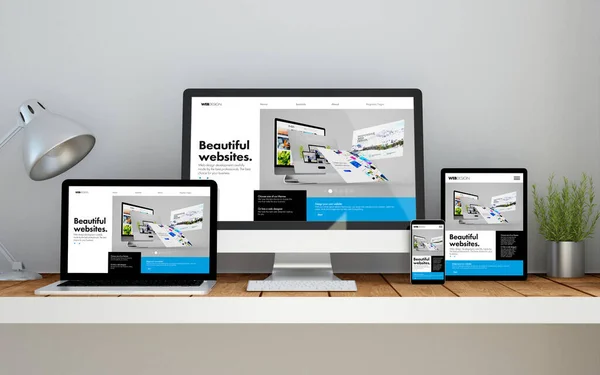Understanding reactive web design :

Reactive web design is a game-changer in the digital world, revolutionizing how websites interact with users.
It’s not just about making sites look good; it’s about crafting them to intuitively adapt to the user’s environment and behavior.
This approach is crucial in a world where people switch seamlessly between devices like smartphones, tablets, and desktops.
At the heart of reactive web design are flexible grids and fluid layouts, which work together to ensure that a website looks perfect on any screen.
Add to this the power of smart CSS media queries, and you have a website that not only changes size but also rearranges content, optimizes images, and enhances usability based on the device being used.
This design philosophy is about being user-centric.
It’s about ensuring that no matter where, how, or on what device a user accesses your site, they get a seamless and engaging experience.
In essence, reactive web design is about making the web not just more accessible, but more responsive to the ever-changing needs of users in the dynamic digital landscape.
Navigating the evolution: traditional vs. reactive web design

In the ever-changing landscape of web development, understanding the evolution from traditional web design to reactive web design is crucial.
This transition marks a significant shift in how we approach digital experiences, catering to the dynamic needs of today’s users.
Below is a comparison table that highlights the fundamental differences between these two design philosophies.
It sheds light on why reactive web design is not just a trend, but a necessary step forward in creating websites that are not only visually appealing but also functionally robust and user-centric.
Whether you’re a seasoned developer or a curious newcomer, this comparison will provide valuable insights into the future direction of web design.
Certainly! Here’s a comparison table outlining the differences between Traditional Web Design and Reactive Web Design:
| Feature | Traditional Web Design | Reactive Web Design |
|---|---|---|
| Responsiveness | Limited; often requires separate mobile and desktop versions. | Highly responsive; adapts seamlessly to any screen size. |
| Load Time | Can be slower, especially on mobile devices. | Optimized for faster loading across all devices. |
| User Experience | Often inconsistent across different devices. | Uniform and intuitive experience on all devices. |
| SEO Performance | May suffer due to lack of mobile optimization and slower load times. | Enhanced due to mobile-first approach and improved load times. |
| Future-Proofing | Requires updates as new devices and screen sizes emerge. | Naturally adapts to new screen sizes and devices. |
The core principles of reactive web design :
Reactive Web Design is revolutionizing the way we interact with the web.
It’s not just a design philosophy; it’s a commitment to user-centric, adaptive, and responsive experiences.
Here’s a closer look at its core principles:
Instant loads with skeleton screens :

Imagine this :
You click on a link, and instead of the all-too-familiar loading spinner, you’re greeted with an immediate outline of the page.
This is the power of skeleton screens in action.
It’s like getting a sneak peek of a masterpiece before it’s fully painted.
This approach is about more than just aesthetics; it’s about keeping users engaged and eliminating the guesswork of whether a page is loading.
Major platforms like Facebook have adopted this technique, showcasing a layout that fills with content in real time.
It’s a subtle yet powerful way to enhance the user experience (UX), making every interaction feel swift and responsive.
Stable loads via predefined sizes :

We’ve all experienced the frustration of a webpage where content jumps around as it loads.
Reactive web design addresses this head-on with predefined sizes for elements.
By setting these sizes, the layout remains stable and predictable, even as different parts of the page load.
This stability is crucial, especially on slower connections where elements might load asynchronously.
It’s about creating a smooth, user-friendly experience where the content stays put, allowing users to start interacting with the page without waiting for every element to load.
It’s a thoughtful approach to design that respects the user’s time and enhances accessibility.
Adaptive layouts :

Reactive Web Design goes beyond simply fitting content to a screen size.
Adaptive Layouts are about creating an experience that molds to the user’s device, orientation, and preferences.
Whether you’re browsing on a desktop, swiping through a tablet, or navigating on a smartphone, the experience remains consistent and intuitive.
It’s like having a website that understands and adapts to your needs, no matter how or where you access it.
This adaptability is key in today’s diverse device landscape, ensuring that users get a seamless and engaging experience tailored to their context.
In the realm of reactive web design, the focus is squarely on the user.
It’s about crafting a web experience that’s as flexible and dynamic as the users themselves.
This approach isn’t just about keeping up with the latest trends; it’s about meeting and exceeding user expectations.
It’s about delivering a seamless, engaging, and responsive web experience that feels tailor-made for every user, every time.
In a world where digital interaction is a daily norm, reactive web design is not just the future; it’s what users today need – a web experience that’s intuitive, fast, and delightfully responsive.
Benefits of embracing reactive web design:
Reactive Web Design isn’t just a trend; it’s a strategic approach that brings a plethora of benefits to your digital presence.
Let’s dive into why adopting reactive web design is a smart move :
Enhanced user experience (UX):

At the heart of reactive web design is a commitment to the user.
It’s about creating a web experience that’s not just visually appealing but also incredibly intuitive and engaging.
Imagine a website that responds to your every move with fluidity and grace, almost as if it’s reading your mind.
This level of responsiveness keeps users glued to your site, not out of necessity, but because the experience is so seamless and enjoyable.
It’s the difference between a good website and a great one.
Reactive web design ensures that every interaction, every click, feels natural and effortless, making your site a pleasure to navigate.
Improved performance :

In the digital world, speed is king, and reactive web design reigns supreme.
By optimizing loading times and interactions, this approach doesn’t just make your site faster; it makes it smarter.
Faster loading times mean users get what they want when they want it, which is right now.
This speed and efficiency are not just about user satisfaction; they’re also key factors in SEO and search engine rankings.
A reactive web design approach can be the difference between appearing on the first page of search results or getting lost in the digital abyss.
It’s about being seen and staying relevant in the ever-competitive online landscape.
Future-proofing your website :

Technology is constantly evolving, and so are user expectations.
Reactive web design is like having a crystal ball for your website.
It ensures that your site stays ahead of the curve, adapting to new devices, screen sizes, and user preferences as they emerge.
This adaptability means your website won’t just be relevant today; it’ll continue to resonate with users in the future.
It’s an investment in longevity, ensuring that your site remains accessible, engaging, and effective, no matter what the future holds.
In a world where change is the only constant, reactive web design is your website’s ticket to enduring relevance and success.
In summary, reactive web design is more than just a design choice; it’s a strategic decision that can elevate your website to new heights.
It’s about creating an online space that’s not only beautiful but also intelligent, responsive, and future-ready.
Embracing reactive web design is embracing the future of digital interaction, where user experience, performance, and adaptability are not just goals but realities.
Implementing reactive web design:
Implementing reactive web design is like assembling a high-performance engine.
It’s about precision, the right tools, and constant fine-tuning.
Here’s how you can gear up your website with the power of reactive web design :
Start with the basics:

Think of reactive web design as building a house; you start with the foundation.
The basics, like skeleton screens and stable loads, are your building blocks.
Skeleton screens are the blueprint, giving users a glimpse of the page layout before it fully loads, keeping them engaged and reducing bounce rates.
Stable loads, on the other hand, ensure that your content doesn’t play a game of musical chairs as it loads.
This stability is key to a smooth, frustration-free user experience.
It’s about laying the groundwork for a website that’s not just reactive but also reliable and user-friendly.
Use the right tools :

Just as a craftsman needs the right tools, so does a web designer implementing reactive web design.
This is where frameworks and tools come into play.
Leverage the power of frameworks like Bootstrap or Foundation that are designed with reactive principles in mind.
These tools provide a robust starting point, offering pre-designed components and layouts that are responsive out of the box.
They’re like the Swiss Army knife of web design – versatile, powerful, and indispensable.
Using the right tools not only streamlines the development process but also ensures that your site adheres to the best practices of reactive web design.
Test and iterate :

The digital landscape is diverse, and so are the devices and browsers your users will use.
This diversity calls for rigorous testing.
Test your design across different devices, screen sizes, and browsers.
It’s like putting your website through boot camp to ensure it’s fit for every scenario.
But testing is just the start. Be prepared to iterate and make adjustments.
User feedback is invaluable; it’s the compass that guides your design adjustments.
This process of testing and iterating is crucial for fine-tuning your website, ensuring that the user experience is not just good, but exceptional.
Implementing reactive web design is a journey of transforming your website into a dynamic, responsive, and user-focused platform.
It’s about starting with a solid foundation, using the best tools for the job, and continuously refining your design to meet and exceed user expectations.
Embrace these steps, and watch as your website evolves into a responsive powerhouse, ready to deliver an unparalleled user experience.
The future of web design:
In the ever-evolving world of digital design, reactive web design stands not just as a passing trend, but as the beacon of the future.
As we navigate through an increasingly digital landscape, the expectations for web experiences are soaring to new heights.
Reactive web design is at the forefront of this evolution, redefining what it means to interact with the digital world.
A growing demand for instantaneity :

In our fast-paced digital era, patience is a rare commodity.
Users expect and demand instant responses and seamless interactions.
Reactive web design caters to this need for speed and efficiency.
It’s about creating web experiences that are not just fast, but also intuitive and engaging.
As we move forward, this demand for instant, responsive web experiences is only set to increase, making reactive web design not just relevant but essential.
Setting the pace in digital innovation :

By adopting reactive web design, you’re not just keeping up with the current trends; you’re actually leading the charge in digital innovation.
It’s about being a trailblazer in a world where digital presence is paramount.
Reactive web design is the key to unlocking a web experience that’s not only in tune with the user’s needs but also ahead of its time.
It’s a strategic move that positions you at the forefront of the digital curve, setting the pace for others to follow.
Preparing for a reactive future :

The future of web design is unmistakably reactive.
As technology continues to advance, and as new devices and platforms emerge, the principles of reactive web design will become increasingly vital.
It’s about future-proofing your digital presence, ensuring that your website or application remains not just functional but also relevant and engaging, no matter what the future holds.
Embracing reactive web design is embracing a future where adaptability, responsiveness, and user-centricity are not just valued but expected.
In conclusion, the future of web design is intrinsically linked to the principles of reactive web design.
It’s a future where websites and applications respond not just to screen sizes, but to user behavior and preferences.
As we step into this future, reactive web design emerges as the cornerstone of digital innovation, setting the standard for what a truly responsive and user-focused web experience should be.
Conclusion :
As we wrap up our journey through Reactive Web Design, I’m curious to know your take.
Which strategy from today’s discussion are you keen to try?
If you’re looking for expert guidance in implementing these cutting-edge web design strategies, our digital marketing agency is here to help. Reach out to us for tailored solutions that can transform your digital presence.


